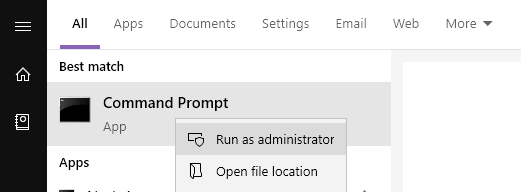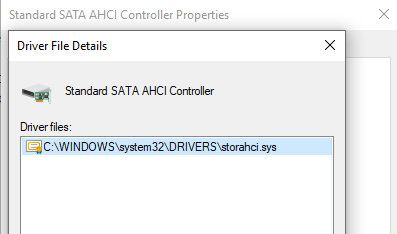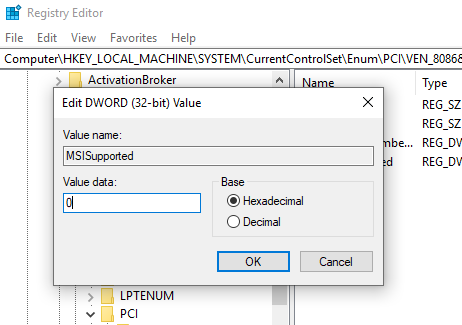I have an old PC at my home with a sophisticated technical configuration. I rarely use the computer and recently I found that the performance was bad despite the high configuration. There's a saying that Windows' performance might degrade over the years and you need to reinstall the operating system to gain back the performance. This is unacceptable since Windows 10 because Microsoft has made Windows 10 really fast and smoother to work even on old computers. I am also receiving regular updates from Microsoft which keeps the software on my old computer stay up to date. However, in recent times when I analyzed what made the performance so bad, I found that the task manager showed Disk always 100% while none of the programs were running.  When I searched online about what was happening, I found several articles to:
When I searched online about what was happening, I found several articles to:
- Disable Windows Search
- Disable Windows SuperFetch
- Disable Antivirus temporarily
- Disable Message Signaled Interrupt (MSI)
- Update Windows Paging Size
- Disable auto prediction on Google Chrome
- Update Device Drivers
- Disk Error Check and Recovery
So I went ahead and did one-after-another: Note: If you are facing the same issue, please try every step as the reason for your task manager to show disk always 100% might be different.
1. Disable Windows Search
Open Command Prompt as Administrator and run the following command: 
net.exe stop "Windows search"
Restart your computer after disabling Windows Search to take effect. Did it resolve? If not, continue to next step.
2. Disable Windows SuperFetch
This step might be the case for some users. For me, SuperFetch service didn't even exist on my computer. In case your computer has SuperFetch service running, run the following command to disable it.
net.exe stop superfetch
Restart your computer and if it worked, I congratulate you on resolving it, if not, well, let us go to check if the next one is the culprit behind the full disk utilization.
3. Disable Antivirus Temporarily
If you are using an Antivirus software, disable it. I used Windows Defender but this change did not affect the disk utilization. If your Antivirus is running a vigorous scan in the background or updating the virus definitions, this is common. Try temporarily disabling Antivirus and check if your issue is resolved. If not, let us go to the next method. If your Antivirus is often utilizing disk to 100%, it is time to switch your Antivirus software to some other vendor. Here is how to choose best Antivirus.
4. Disabled Message Signalled Interrupt (MSI)
Microsoft is aware of the 100% disk utilization issue and has provided a resolution for the same.
- Open Command Prompt as Administrator.
- Type devmgmt.msc
- Under IDE ATA/ATAPI Controllers, go to Properties of Standard SATA AHCI Controller.
- Go to Driver tab and click on Driver Details and if you see storahci.sys, follow the below steps:

- In the Standard SATA AHCI Controller Properties window, go to Details tab and select property as Device instance path.
- Note down the value and replace AHCI_Controller in the next step.
- Now go to regedit and navigate to the following path: HKEY_LOCAL_MACHINE\System\CurrentControlSet\Enum\PCI\<AHCI_Controller>\Device Parameters\Interrupt Management\MessageSignaledInterruptProperties.
- Double click MSISupported and change the value data from 1 to 0.

- Restart your machine.
And again, do not give up if it does not resolve, we still have a few more trials to find which is causing the issue.
5. Update Windows Paging Size
Providing greater paging size might utilize disk a lot and this is because your operating system uses a specified amount of space as RAM. Although the speed will not match the RAM, it solves applications requiring large memory.
- Press Winkey + R and type systempropertiesperformance
- In the Advanced tab, click Change
- Check on Automatically manage paging file size for all drives
Note: If you are going to minimize or maximize the paging memory usage, remember that you should not allocate more than 1.5 times of your physical RAM. For example, if your computer is using a 4 GB RAM, you should not allocate more than (4 x 1024) x 0.5 = 6144 MB.
6. Disable Auto Prediction on Google Chrome
Go to Settings of your Google Chrome browser and search for Use a prediction service to load pages more quickly. If it is enabled, you need to disable and check if your task manager still shows disk always 100%.
7. Update Device Drivers
Your machine might be using outdated drivers which might not be supported for Windows 10. Hence, do a thorough check under Device Manager and update if you notice any outdated device drivers.
8. Disk Error Check and Recovery
Open Command Prompt as Administrator and type the following:
chkdsk.exe /f /r
Restart your computer and the error checking should happen automatically. Note that this might take several hours depending on your disk capacity and the type of drive. For my 1 TB Hard Disk Drive, it took around 4 hours.
Still Desperate? Let's not give up!
I tried all the above methods and did not work. Now you might be angry on me, but you need to understand that the reason for the task manager to show disk always 100% might differ. For some people, the Windows Search might be utilizing the whole disk and their issue gets resolved in first step. If none of the above methods worked, here are the methods that worked for me.
- Whole System Scan using Antivirus
- Disk Defragmentation
Whole System Scan using Antivirus
Your machine might be affected by malware and it might be utilizing the whole disk running in the background discreetly. Do a whole system scan using your Antivirus software. Before scanning, make sure you update your virus definitions. I was using Windows Defender and as soon as it detected threats, things were getting better than previous but still, the graph shown for Disk in Task Manager was not impressive and thus, I want to try out another technique.
Disk Defragmentation
Disk Defragmentation is mandatory to be scheduled every week to run on your computer. This will allow your disk to read data faster. After I did a Disk Defragmentation, the issue was completely resolved. I restarted the machine several times to replicate the issue, and guess what, the disk was no longer utilizing 100%. My old computer started to perform lightning-fast like a new one. I even saw some of the online articles recommending to purchase an SSD, but what if the reason is with the malware. The malware runs in the background even if you buy a new hard disk, but hey, the reason can differ. If your hard disk is physically damaged, it is recommended to replace your hard disk, but do not spend a huge sum of a penny without following the above steps.
